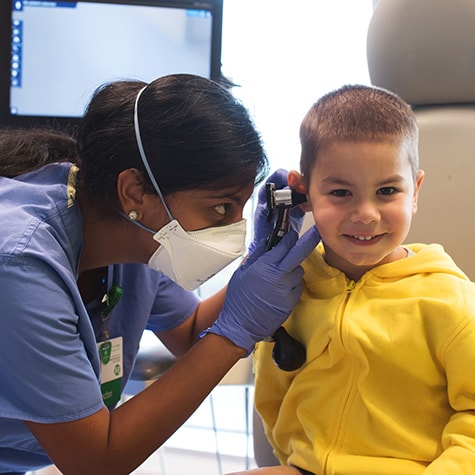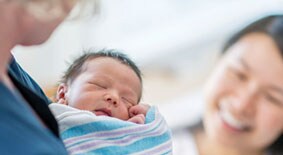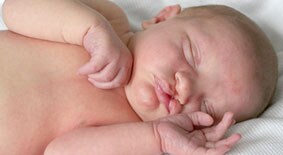Kristan Alfonso, MD, joined Children’s Healthcare of Atlanta as a Pediatric Otolaryngologist and joined Emory University School of Medicine as an Assistant Professor in 2019. She came to Georgia from Houston, Texas, where she completed her fellowship training and served as a pediatric otolaryngologist at Texas Children’s Hospital.
This content is general information and is not specific medical advice. Always consult with a doctor or healthcare provider if you have any questions or concerns about the health of a child. In case of an urgent concern or emergency, call 911 or go to the nearest emergency department right away. Some physicians and affiliated healthcare professionals on the Children’s Healthcare of Atlanta team are independent providers and are not our employees.
Innovative Magnetic Hearing Devices Offer New Option for Patients With Hearing Loss
Among the first to offer Bonebridge and Osia implants
As many as 3 babies in every 1,000 births are born with some type of hearing loss, and 6 school-age children in every 1,000 have hearing issues. Children’s Healthcare of Atlanta is leading the way when it comes to the services we offer pediatric patients who suffer from hearing loss.
Hearing devices are not a one-size-fits-all solution for kids who have hearing issues, so our team of specially trained otolaryngologists tailors care plans using advanced technology to address concerns.
In an effort to provide our patients and families with the best hearing loss solutions to meet their needs, we offer FDA-approved, active magnetic hearing devices like Bonebridge and Cochlear Osia.
What are active transduction implants?
Kristan Alfonso, MD, a Pediatric Otolaryngologist at Children’s, implanted the first Bonebridge device into a pediatric patient in Georgia, followed by implanting one of the first Osia devices into a pediatric patient in Georgia.
“There’s been such an improvement in the technology of these devices over the past decade, especially for bone conduction implants,” Dr. Alfonso explains. “Traditionally, this type of device would require you to clip on the hearing aid processor. It led to good results, but you could have problems with infections around the abutment.”

Active magnetic hearing devices differ from more traditional cochlear implants. They have lower rates of infection, more flexibility in activities and newer technology.
The Bonebridge and Osia devices are placed under the skin behind the ear and implanted into the bone. The external hearing aid processor sticks on using a magnet.
“This can help lead to excellent hearing results by having the vibrational capacity within the implanted portion itself, compared to other devices available before,” adds Dr. Alfonso.
The Bonebridge and Osia devices are called active transduction, or direct drive, implants compared to the more traditional bone-anchored devices. They do not have to be attached to an abutment or post that protrudes through the skin. By allowing the skin to stay intact, a patient does not have to deal with the care and maintenance involved in implants that have abutments, therefore, there is improved cosmesis.
In addition, active transduction implants like these allow signals to be transferred from the external device to the internal device through the skin. The internal device then converts these signals into mechanical vibrations to transfer sound through the bone to a child’s hearing nerve. This differs from more traditional devices that have the vibratory mechanism within the external processor.
Bonebridge and Osia can be fitted with the external processor much earlier than traditional bone-anchored devices, within one month after a child’s surgery. They also have options for waterproof covers and help reduce feedback since the transducer is under the skin.
Both devices are FDA approved for children ages 12 and older for conductive hearing loss, mixed hearing loss and single-sided deafness. However, in some countries, Bonebridge is approved for children ages 5 and older, so our team anticipates the devices being approved for younger patients in the U.S. in the near future.
For patients who may need ear reconstruction—for example, if they are born without an external ear—both of these devices are operable solutions even before the reconstruction procedure is completed.
What are the advantages of active magnetic hearing devices for children?
Advantages of the two devices include:
- Children can participate in water activities like swimming.
- Children can lie down on their sides comfortably.
- Children can wear helmets when riding their bikes or playing sports.
- Hats are easier to wear and not so cumbersome.
- Sound quality is better.
- There are no open wounds.
- The devices are easy to maintain and cosmetically appealing.
- The devices connect to Bluetooth-compatible technology.
- Users experience less background noise and can focus on targeted noise or sounds.
We are setting the bar high for children in Georgia who need surgery to implant these devices by being the first facility in the state with a Level 1 Children’s Surgery Verification from the American College of Surgeons. There are fewer than 30 verified Level 1 facilities with Children’s Surgery Verification across the country, and we have two.
Clinical Success at Children's

When it comes to your child, where you take them matters.
If your child has ear infections, strep throat or other issues that impact their ears, nose or throat, find a pediatric otolaryngologist or click the link below to schedule an appointment.
Make an AppointmentContact Us 404-785-DOCS (3627)


